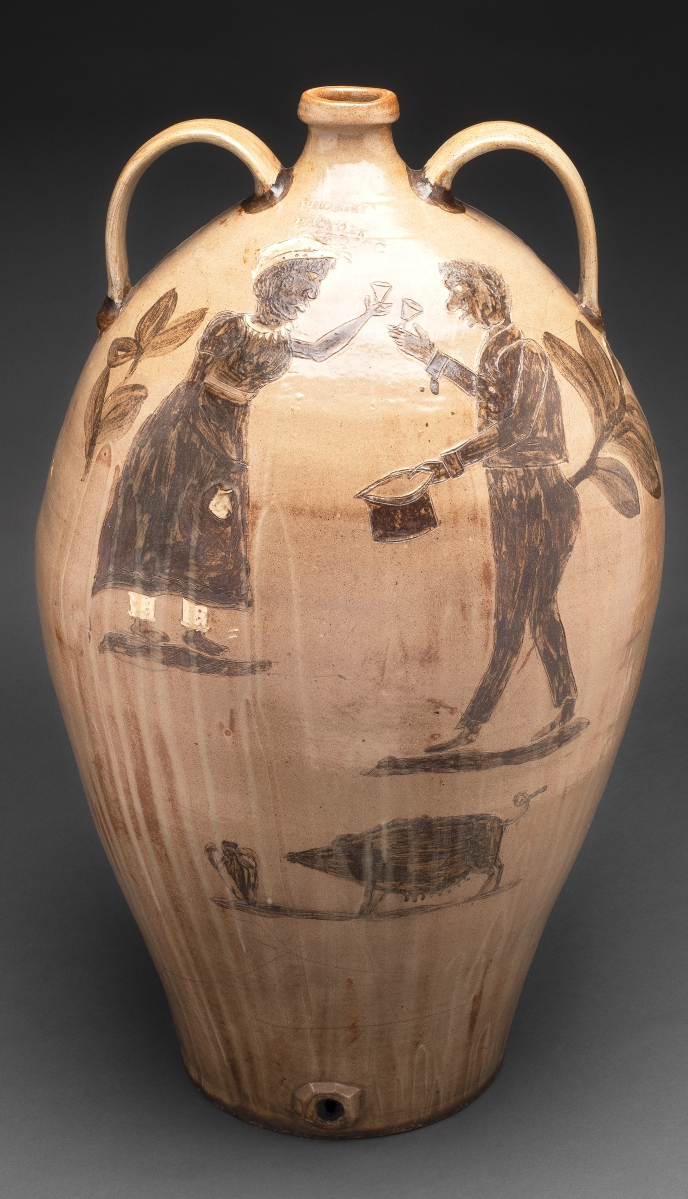
The scene on this watercooler, a couple in fancy dress with a hog below, is often interpreted as a slave wedding, and is a rare figural depiction of Black life and regional traditions in Edgefield stoneware, write Spinozzi and Hughes. Detail, watercooler by an unrecorded potter, probably Thomas M. Chandler Jr (1810-1854), Phoenix Stone Ware Factory, Old Edgefield District, S.C., circa 1840. Alkaline-glazed stoneware with iron and kaolin slip, height 31¼ inches. Collection of the High Museum of Art (1996.132). Photo by Michael McKelvey / Courtesy of the High Museum of Art.
By Laura Beach
NEW YORK CITY – On view from September 9 at the Metropolitan Museum of Art (MMA) and traveling thereafter, “Hear Me Now: The Black Potters of Old Edgefield, South Carolina” has long been anticipated by Americana enthusiasts. Though in some respects narrowly focused and physically not large – it numbers 65 objects, including five fragments and seven works by contemporary artists – the show and its accompanying catalog are monumental, representing a fundamental shift in approach to a complicated group of African American-made objects and a milestone acknowledgment of the soft bigotry of past oversight by the nation’s foremost art museum.
What defines this revisionist history is the project team’s insistence that a chorus of voices other than its own be heard. In collaboration with Ethan W. Lasser, chairman of the Art of the Americas department at the Museum of Fine Arts, Boston (MFA), and Jason R. Young, associate professor of history at the University of Michigan, Ann Arbor, MMA associate curator Adrienne Spinozzi has crafted a presentation that is nuanced and provocative, with a call-and-response cadence reminiscent of an African American spiritual.
Over the past 150 years, Edgefield stoneware has gone from a sturdy standard of the Southern kitchen and pantry to museum trophy and rarified collector’s item. Spurred by institutional bidding, the market reached spectacular new heights in 2021 when Crocker Farm auctioned a large, inscribed jar by Edgefield’s poet laureate, the enslaved potter David Drake, for $1.56 million, a world record for American pottery at auction. As contemporary Black artists and intellectuals engaged with the wares, it became clear that the Edgefield story needed retelling.
Roughly 160 miles east of Atlanta and encompassing portions of five counties, the Old Edgefield District, as it was designated between 1785 to 1865, supported at least 12 pottery sites between 1815 and the 1890s. Recent archaeological excavations confirm the scale of the operations, which shipped wares up to 150 miles in all directions and collectively exemplified industrial slavery, an understudied dimension of the antebellum Southern economy.
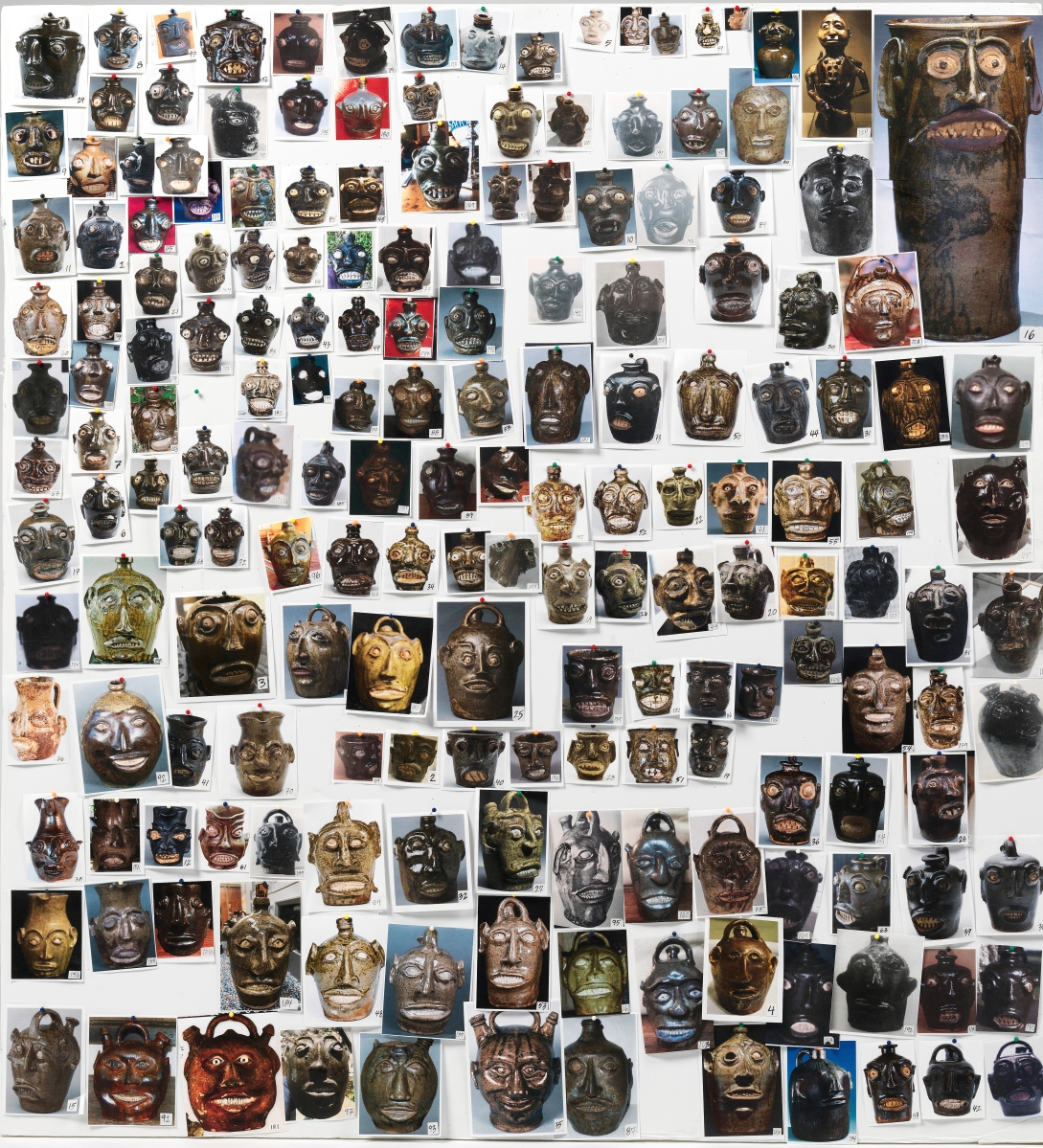
Detail of board tracking known face vessels, begun in 2018 by Katherine C. Hughes and Adrienne Spinozzi. Spinozzi’s team confirmed nearly 180 extant Edgefield face vessels made by and for enslaved potters. The form appeared in Edgefield in the 1850s, coinciding with an influx of captives from Africa. Image courtesy Metropolitan Museum of Art, Eileen Travell photo.
Having discovered kaolin in the region, Dr Abner Landrum (1785-1859) is recognized as the first in the United States to make alkaline-glazed stoneware, doing so at his Pottersville Stoneware Manufactory. Other manufacturers, from the Harvey & Reuben Drake Factory (1828-32) to the Thomas M. Chandler Pottery (1850-52) and the Miles Mill Pottery (1867-85), followed.
Enslaved African Americans, who by 1830 formed a majority of the region’s population, operated but did not own the businesses. Skilled craftspeople, they produced quantities of utilitarian stoneware – bowls, churns, pitchers, cups, crocks and jugs – plus monumental food-storage jars and, uniquely, watercoolers with capacities of up to 40 gallons. Scholars, among them recently the collectors Corbett E. Toussaint and April L. Hynes, have worked to identify individual potters and their descendants by name, a task made difficult by slavery’s systemic repression of Black identity and accomplishment. The names stamped and incised on most Edgefield stoneware belong to owners of the potteries, not makers.
“Our hope is that as technology progresses, we will be able to build on the genealogical and archeological work underway, as well as other methodologies for doing this research,” says Spinozzi, whose team gleaned subtle clues to authorship in the form of maker’s marks, symbols, handprints and decoration.
The Civil War marked the beginning of the end of the industry. Some newly freed craftspeople went to work for their former enslavers, others – among them John Chandler, who migrated to Guadalupe County, Texas, where he was part of the Durham-Chandler-Wilson Pottery – moved west to establish businesses of their own. Though collectors have been gathering specimens, particularly face vessels, for more than a century, much Edgefield pottery has likely not survived, the organizers say.
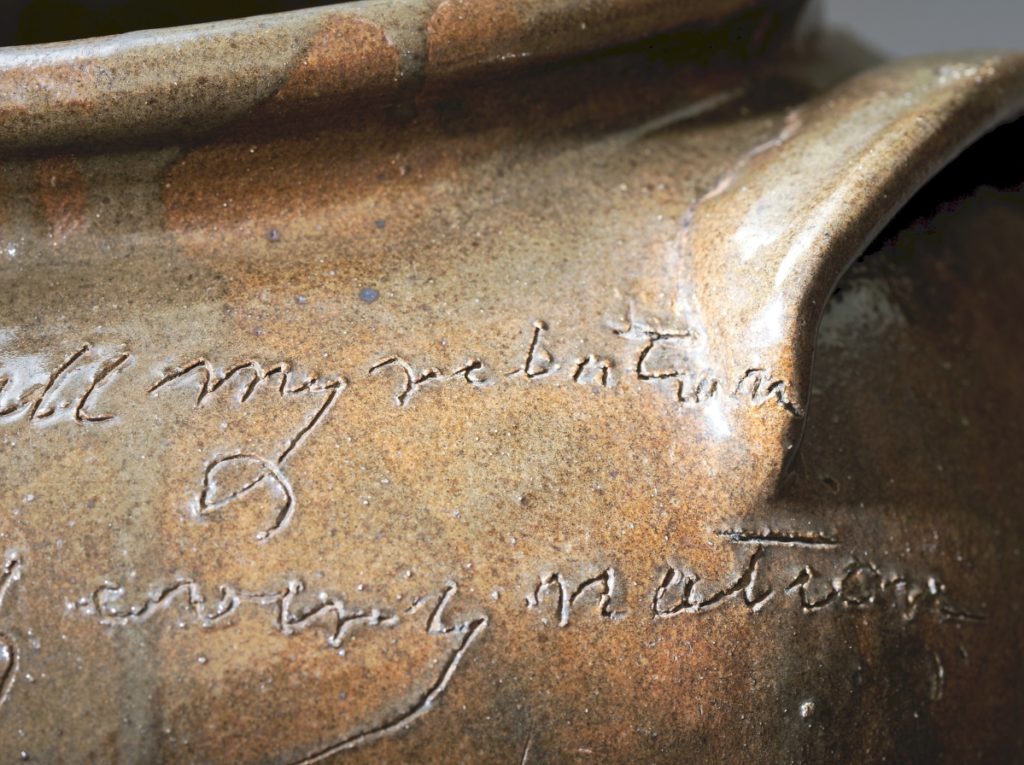
“The poem on this jar — Dave’s most significant literary contribution — illuminates the potter’s own experience but also transcends it,” writes Adrienne Spinozzi. Storage jar by Dave (later recorded as David Drake, b circa 1801-d 1870s), Stony Bluff Manufactory (circa 1848-67), Old Edgefield District, S.C., 1857, alkaline-glazed stoneware, height 19 inches. Collection of Greenville County Museum of Art.
Installed in Gallery 955 of the Met’s Robert Lehman Wing, “Here Me Now” touches briefly on Native American ceramic traditions in pre-contact western South Carolina before focusing on several distinct groups of Edgefield pottery: utilitarian wares, some with figural decoration; face vessels, most by unidentified craftspeople; and signed, dated and inscribed vessels by David Drake. Sprinkled throughout the gallery and offering evidence of Edgefield’s continuing influence are a handful of ceramics, drawings and mixed-media pieces, some sumptuous in scale, by contemporary Black artists. Innovatively, exhibition labels and the museum’s audio guide feature the voices of eight experts of varied perspective.
Given their visceral appeal, it is perhaps not surprising that jugs and jars with hand-modeled facial features – in the past called “grotesques,” “voodoo jugs” and, derogatively, “monkey jugs” – were among the first examples of Edgefield pottery sought by curio collectors, notably snowbird visitors to nearby Aiken, S.C., and institutions, beginning with the Charleston Museum in 1902.
Spinozzi’s team confirmed roughly 180 extant Edgefield face vessels, made by and for enslaved potters, and apparently not originally for sale. According to the researchers, the form appeared in Edgefield in the 1850s, coinciding with an influx of captives who brought with them African cultural and spiritual traditions. Surveying the literature, co-organizer Young speculates that the vessels may have been intended as whimsies, as receptacles for water or alcoholic spirits, or perhaps even for use in burial or funerary rituals.
Displayed together on one wall, the face vessels make a striking presentation. Spinozzi notes, “We thought it was important to show them together so visitors would have insight into some of the stylistic decisions made by the potters. We’ve identified roughly ten different groupings with common characteristics, reflecting either individual makers or groups of makers, and the exhibition presents some of these groups. More face vessels are coming to light, but we still feel we are in the beginning stages of our research.”
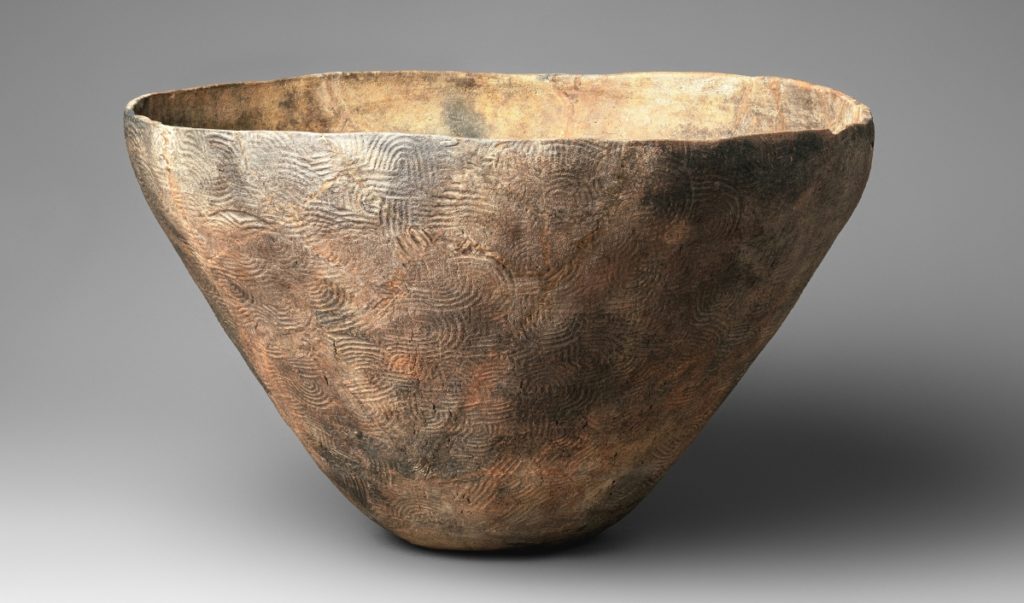
The exhibition opens with a reference to the Native American clay tradition that existed in the Carolinas prior to settlement by European and African Americans. Attributed to the Woodland culture, circa 1500, this bowl by an unrecorded potter is the earliest work in the exhibition. Earthenware, height 15¼ inches. South Carolina State Museum, Columbia, S.C. (SC80.15.368). Image courtesy Metropolitan Museum of Art, Eileen Travell photo.
Greeting visitors at the exhibition’s entrance are 12 vessels by the enslaved potter who sometimes signed his pieces “Dave,” and who upon emancipation took the surname of one of his former enslavers, Drake. Spinozzi notes, “Each vessel is in its own case and is meant to be viewed in the round. It’s a powerful installation.” Among Dave’s 50 largest pots are works extraordinary in their scale, wit and radical assertion of free expression. Signed and inscribed with short verses, dates or both, they resonate in our compulsively communicative age.
Dave was born around 1801 and died in the 1870s. Beginning in the 1820s, he likely made thousands of vessels, most of which were relatively nondescript commercial pieces. His first signed pieces of the early 1830s coincided with South Carolina’s furious attempt to preempt the anticipated end of the legal Atlantic slave trade by increasing its importation of slaves and forbidding literacy among African Americans.
How Dave learned to read and write remains a mystery. Harvard professor and catalog contributor Vincent Brown speculates that it may relate to enslaver Harvey Drake’s business partner, Abner Landrum, and his newspaper, the Edgefield Hive. Dave’s talent appears to have insulated him against reproach, though scholars question whether he lost his leg in an accident, as went the official account, or whether he was maimed as punishment, a not unusual occurrence among the enslaved.
Here Me Now offers a compendium of Dave’s known verses. Inscribed in flowing hand by Dave, then working for the Drake & Rhodes Factory (1832-36), the first script appears on a two-handled jar dated June 12, 1834. It reads simply “Concatination,” a word meaning a linked series of things or events. Here the word’s use is obscure, other than to suggest the potter’s access to penmanship guides prior to South Carolina’s passing of more punitive antiliteracy codes in December 1834. Dave’s last known inscribed and dated jar of May 3, 1862, calls on sinners to repent, a message that may have abolitionist overtones.
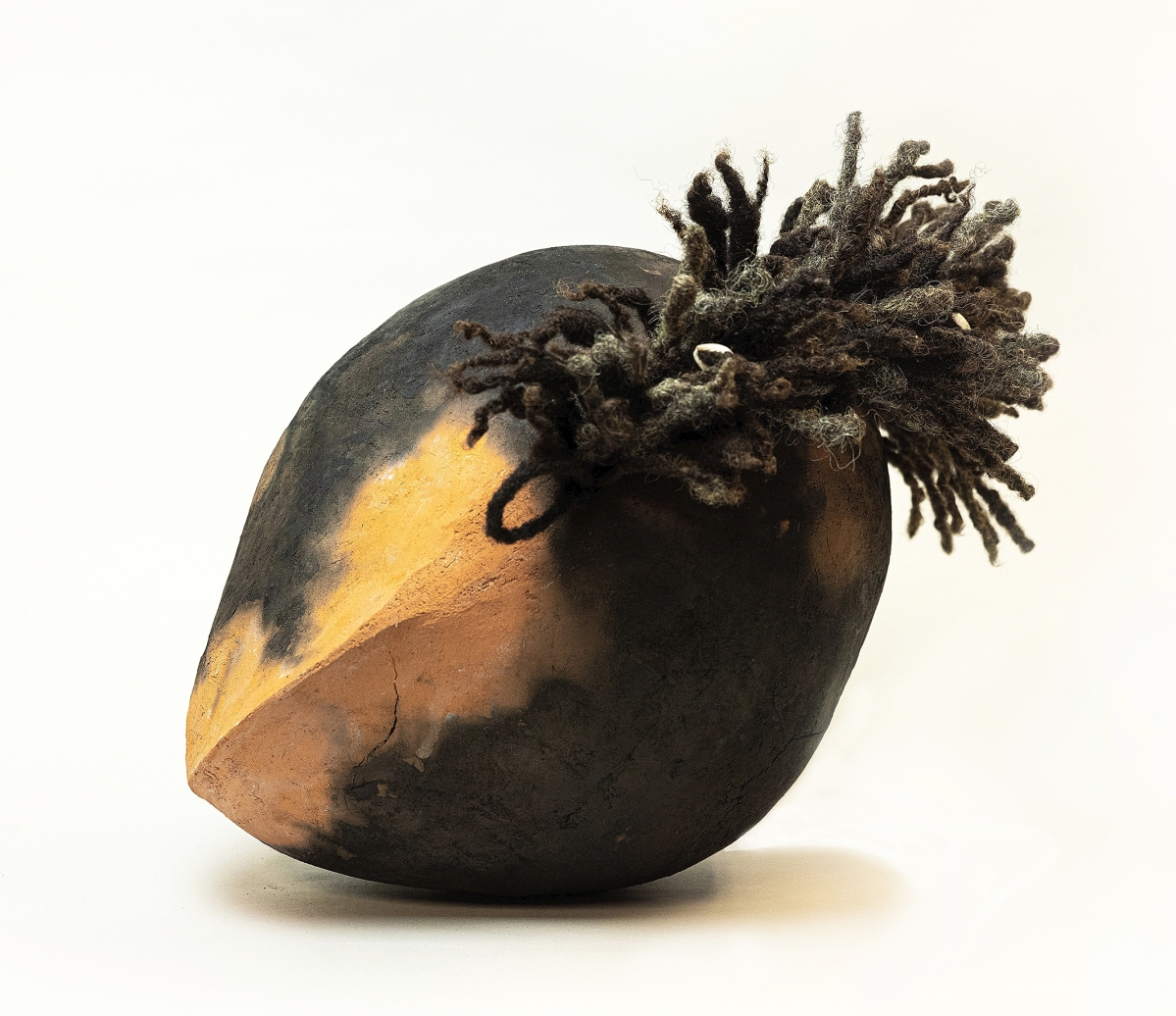
Artist Adebunmi Gbadebo (b 1992) forges a physical connection with the plantation home of her ancestors in “K.S.,” a sculpture of 2021. True Blue Plantation cemetery soil and human locs from Aaron Wilson Watson, Kelsey Jackson and Cheryl Person; length 22 inches. Museum of Fine Arts, Boston; courtesy of the artist and Claire Oliver Gallery, New York; Aaron Wilson Watson photo.
The most compelling of Dave’s works is a 19-inch-tall jar, ovoid in shape, with tiny, ear-like handles and warm, brown color. Signed and dated August 16, 1857, its rhymed inscription asks deferentially, “I wonder where is all my relation/ Friendship to all – and every nation,” a reference, perhaps, to the sale of Dave’s family to a planter 500 miles distant. “These 13 words are among the most powerful and emotive in the history of American letters,” write essayists Michael J. Bramwell, the MFA’s newly named Linde curator of folk and self-taught art, and exhibition co-curator Lasser, who rank Dave with Frederick Douglass and other great voices of the abolition movement.
Cited throughout the catalog text, Chipstone Foundation deserves special mention for raising awareness of Edgefield pottery in general and Dave in particular. In partnership with the Wunsch Americana Foundation, the Milwaukee-based organization underwrote a think tank at the Met in 2016 with an eye toward stimulating dialogue about new approaches to museum display and interpretation in the American arts and material culture. The Chipstone journal Ceramics in America has led the way with studies considering African American influences in ceramics. Moreover, it was Lasser, then Chipstone’s curator, who introduced Dave to the contemporary art field with the 2010 Milwaukee Art Museum exhibition “To Speculate Darkly: Theaster Gates and Dave the Potter.” Lasser later advocated for inclusion of a contemporary component in “Here Me Now.”
Chipstone Foundation’s executive director and chief curator Jon Prown asks, “Thinking critically, one key question regarding ‘Hear Me Now’ is how meaningfully it shifts the field forward and builds upon previous studies of the topic by opening new interpretive pathways. Does the initiative expand the range of historical narratives we pursue as curators and historians? Does this research substantively change how we think about our historical and material past? When it comes to museum-based projects such as this one, our curatorial efforts in the American decorative arts world need to walk-the-walk. That is the great hope we all have for the collaborative Met/MFA Boston project.”
“Hear Me Now” draws arresting parallels between Edgefield pottery and contemporary work by artists such as Gates (b 1973), who has called David Drake “one of the most important craft figures in American history,” and Simone Leigh (b 1967), winner of a Golden Lion award at the 2022 Venice Biennale.
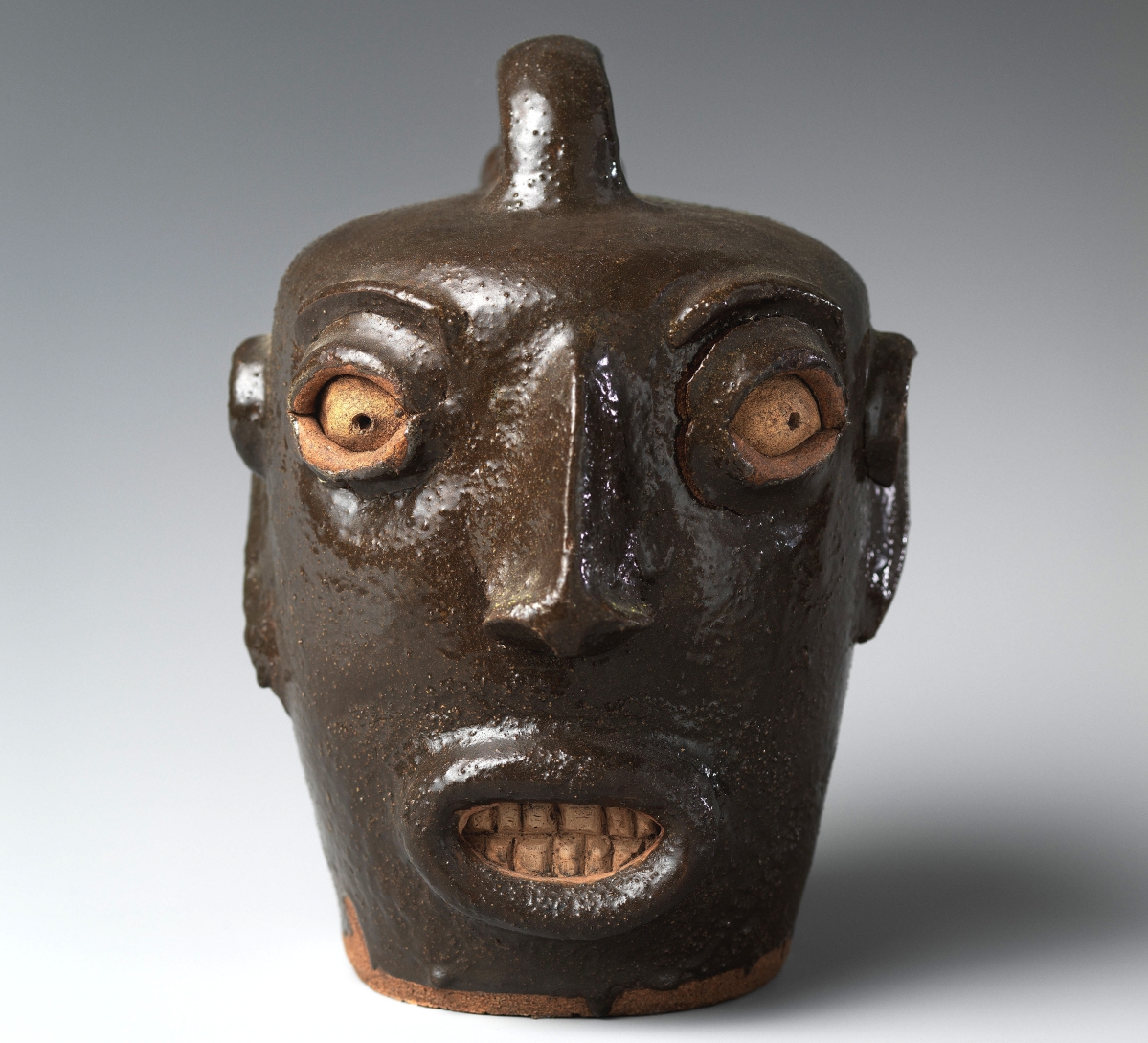
Archaeological evidence suggests this face jug may have been made at Miles Mill Pottery (1867-85), opened by Lewis J. Miles after emancipation and following the closing of his nearby Stony Bluff Manufactory. Face jug by unrecorded Old Edgefield District potter, 1867-85, alkaline-glazed stoneware with kaolin, height 8 inches. Hudgins Family Collection, New York. Image courtesy Metropolitan Museum of Art, Eileen Travell photo.
Opposite the face vessels in the present display is “Large Jug” by Leigh. The 62½-inch-tall stoneware sculpture calls to mind in form and proportion, if not scale, the nearby harvest face vessel of circa 1850-80, acquired by the Met in 2017 and so-called because of its horizontal handle. There the likeness ends. Glazed white, “Large Jug” is embellished in high relief with elements resembling cowrie shells or perhaps human anatomy. Leigh included a closely related piece in her Biennale presentation, citing artistic traditions of Africa and the African diaspora as influences and noting her sustained interest in issues surrounding Black femininity.
Spinozzi says, “We were thrilled when Simone joined our project during its planning stage. We shared with her photographs of our face-vessel board, the harvest face vessel and James A. Palmer’s stereograph from his 1882 series ‘Aiken and Vicinity,’ which features an almost identical face vessel. It’s fascinating to see how Simone engaged with the material.”
Another crucial piece is the moving “K.S.,” a 2021 work by Adebunmi Gbadebo (b 1992), whose elegantly reductive representation of a human skull joins clay collected at the former True Blue Plantation in Fort Motte, S.C., with locs of Black hair. As Lasser explains, “There, at the burial ground for the enslaved, she collects clay for her sculptures, turning the earth that ran through the hands of her ancestors into vessels that commemorate the history of her family.”
Spinozzi acknowledges the many difficulties inherent in presenting Edgefield pottery, asking, “What does it mean to elevate objects made by forced labor and celebrate them as creative masterworks? How can artistic agency be understood in this context? How can we give space and a voice to these objects and the people who made them? And who is telling these stories?”
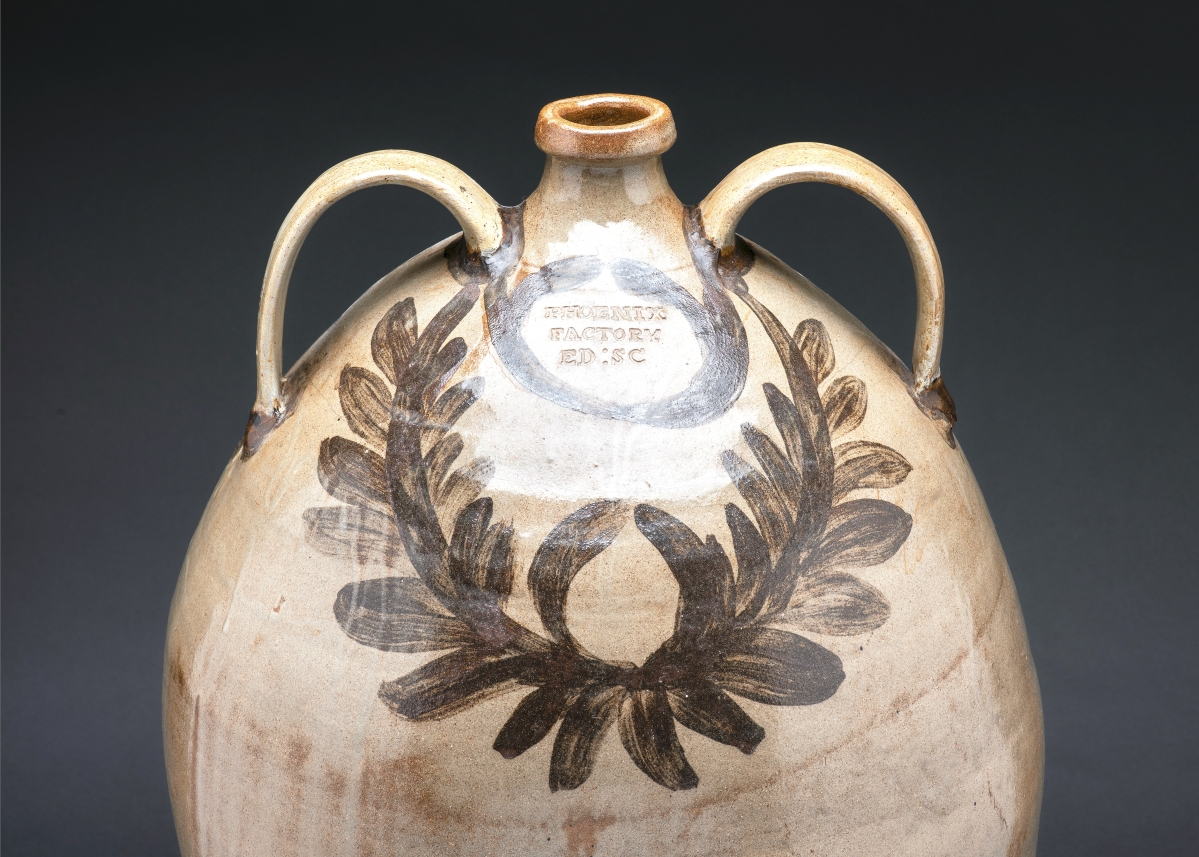
Detail of a watercooler by an unrecorded potter, probably Thomas M. Chandler Jr (1810-1854), Phoenix Stone Ware Factory, Old Edgefield District, S.C., circa 1840. Alkaline-glazed stoneware with iron and kaolin slip, height 31¼ inches. Collection of the High Museum of Art (1996.132). Photo by Michael McKelvey / Courtesy of the High Museum of Art.
As incomplete as the Edgefield narrative remains, “Hear Me Now” is a brave, powerful step toward setting a flawed record straight.
Edited by Adrienne Spinozzi, Hear Me Now: The Black Potter of Old Edgefield, South Carolina was published by the Metropolitan Museum of Art and is distributed by Yale University Press. In addition to Spinozzi, Lasser, Young, Bramwell, Brown and Leigh, its contributors include the Met’s former Peggy N. Gerry research scholar Katherine C. Hughes, now a doctoral candidate in public history at Middle Tennessee State University and a curator at the McKissick Museum in South Carolina.
Following its close in New York on February 5, 2023, “Here Me Now” will travel to the Museum of Fine Arts, Boston (March 6-July 9, 2023), the University of Michigan Museum of Art, Ann Arbor (August 26, 2023-January 7, 2024) and the High Museum of Art, Atlanta (February 16-May 12, 2024).
The Metropolitan Museum of Art is at 1000 Fifth Avenue. For information, www.metmuseum.org or 212-535-7710.




















